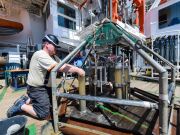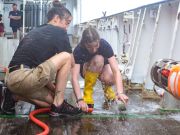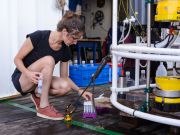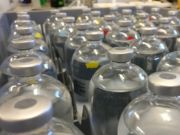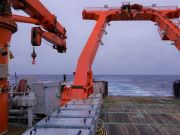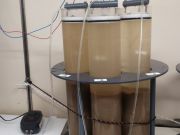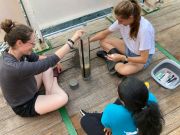
Ocean interfaces under global changes –
Exploring the fate of the Amazon River plume
27.05.2021 – At the center of the N-Cycle
Though I’ve read blog entries, carried out fieldwork in freshwater systems, and heard about big research expeditions, nothing could have prepared me for this experience. 52 days later, I can now say I truly understand how research is conducted in the open ocean. After several weeks of sampling to get low- and high-resolution profiles of the water column and rate measurements, I feel a little exhausted, but at the same time proud and giddy with excitement.
The marine Nitrogen cycle is a fascinating mixture of reactions and processes. Once consumed by phytoplankton and transferred to higher trophic levels in zooplankton and mesozooplankton, where does all the Nitrogen go? How do we close the circle? To answer these questions, it is interesting to go slightly deeper, to look at what happens when all the organisms that ate Nitrogen die, and start sinking slowly in the water column. Light gets less and less intense, preventing phytoplankton from growing, but not everything is lifeless and inactive there, quite the contrary! In addition to all the animals feeding on detritus, hundreds of billions of bacteria proliferate, converting the complex sinking organic matter into more simple Nitrogen species.
First, one group of bacteria transforms the organic matter to ammonium (NH4+), during a process called ammonification. Then, two other groups of bacteria take over and use oxygen to convert NH4+ to NO2-, and NO2- to NO3-. This two-step conversion process from NH4+ to NO3- is called nitrification. When most of the oxygen has been consumed, these organisms cannot live anymore. However, another kind of bacteria can use a wide range of other molecules to survive in these anoxic environment, and the easiest to use is NO3-. The consumption of NO3-, converted in N2, is a process called denitrification. The circle is complete!
This complex coupling between nitrification and denitrification is extremely interesting to us, as it is thanks to it that our Nitrogen cycle is all wrapped up. Measuring nitrification rates is a very hard work. After hours of hard sampling alone at the CTD, Noémie finally had her samples but the work had not even started yet. After injecting enriched 15NH4+ to her samples, to check how much of 15NO3- would be formed via nitrification, she had to go down into the cold room. This dark room was set up to simulate the ice cold temperatures found at the seafloor, where most of her samples were coming from. Then, hours and hours of filtration followed, alone with her samples and thoughts. Nobody ever came to look for her, but she did her work and hopefully, the results from the mass spectrometer will make it worth this loneliness.
Another reason why nitrification and denitrification are so important is nitrous oxide (N2O). Emma’s objective is to determine the main controls on N2O production processes, as this specie is produced and consumed during nitrification and denitrification. N2O is a trace component of the atmosphere, but its concentration has increased over the last century (IPCC 2013). It’s stable in the troposphere, with a lifetime of up to 120 years, and mixes into the stratosphere, where it is photochemically decomposed to form nitric oxide (NO). NO, in turn, is involved in the catalytic destruction of ozone, making N2O an important ozone destroying chemical. With a global warming potential about 300-fold greater than CO2 on a 100-year time scale, N2O is a major component of global change for the near future, and the open ocean accounts for up to ~35 % of global N2O emissions. Nothing is known about the processes behind N2O accumulation and consumption along the freshwater-marine continuum in the Amazon River plume.
On each station, water from the CTD rosette was sampled in glass serum bottles or transferred to canisters. To determine the natural abundance of N2O isotopes, which can give insights on the sources of N2O, a volume of sodium hydroxide was added directly to fix the water samples. In addition to this experiments, samples for N2O production rates were also taken. The samples were treated with different tracers, like 15NH4 + 14NO2, 15NO2 + 14NH4, 15NO3 + 14NO2 or 15N-AA + 14NO2. The glass serum bottles were incubated for 24 h with different time points and oxygen measurements in between. The incubation was implemented under dark and light conditions and in situ temperature. At the different sampling points, mercury was added directly to stop all biological activity. At home in the lab in Basel the samples will soon be run.
We have come full circle! It was very exciting to finally sample, do experiments, and we feel very lucky that we had the amazing opportunity to go to the Amazon River Plume. It was exhausting and say that we can rest now would be a lie. As for the Nitrogen, we need to complete our cruise circle and for that, we start packing things, clean labs and write reports. Enough to keep ourselves busy until we are back on land!
Text: Burtscher E., Choisnard N., Voss M. (all IOW) | click pictures to enlarge
| Expedition: | M174 |
| Mission: | MeNARP |
| Start: | 12.04.2021 - Las Palmas |
| Destination: | 31.05.2021 - Emden |
